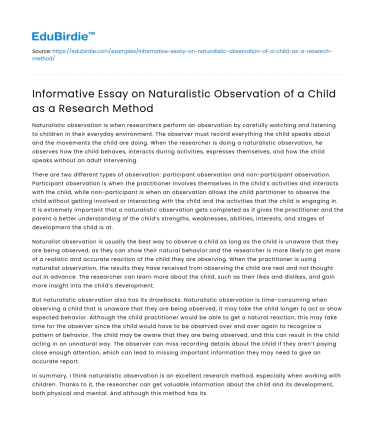Naturalistic observation is when researchers perform an observation by carefully watching and listening to children in their everyday environment. The observer must record everything the child speaks about and the movements the child are doing. When the researcher is doing a naturalistic observation, he observes how the child behaves, interacts during activities, expresses themselves, and how the child speaks without an adult intervening.
There are two different types of observation: participant observation and non-participant observation. Participant observation is when the practitioner involves themselves in the child’s activities and interacts with the child, while non-participant is when an observation allows the child partitioner to observe the child without getting involved or interacting with the child and the activities that the child is engaging in. It is extremely important that a naturalistic observation gets completed as it gives the practitioner and the parent a better understanding of the child’s strengths, weaknesses, abilities, interests, and stages of development the child is at.
Save your time!
We can take care of your essay
- Proper editing and formatting
- Free revision, title page, and bibliography
- Flexible prices and money-back guarantee
Naturalist observation is usually the best way to observe a child as long as the child is unaware that they are being observed, as they can show their natural behavior and the researcher is more likely to get more of a realistic and accurate reaction of the child they are observing. When the practitioner is using naturalist observation, the results they have received from observing the child are real and not thought out in advance. The researcher can learn more about the child, such as their likes and dislikes, and gain more insight into the child’s development.
But naturalistic observation also has its drawbacks. Naturalistic observation is time-consuming when observing a child that is unaware that they are being observed, it may take the child longer to act or show expected behavior. Although the child practitioner would be able to get a natural reaction, this may take time for the observer since the child would have to be observed over and over again to recognize a pattern of behavior. The child may be aware that they are being observed, and this can result in the child acting in an unnatural way. The observer can miss recording details about the child if they aren’t paying close enough attention, which can lead to missing important information they may need to give an accurate report.
In summary, I think naturalistic observation is an excellent research method, especially when working with children. Thanks to it, the researcher can get valuable information about the child and its development, both physical and mental. And although this method has its drawbacks, the advantages still exceed.






 Stuck on your essay?
Stuck on your essay?

